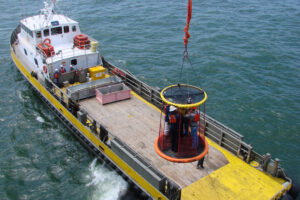Industry adapts as COVID-19 pandemic introduces logistical challenges for rig crew transfers
Personnel movement takes on new complexities amid social distancing and quarantine requirements, as well as reduced availability of commercial flights
By Stephen Whitfield, Associate Editor
The rig crew transfer process has taken on new challenges in a world defined by the outbreak of COVID-19. Extensive pre-screening questionnaires, quarantines and temperature checks are par for the course for personnel seeking to get on or off a rig, not to mention mounting difficulties in navigating the travel restrictions imposed by various countries and coping with the shortage of available commercial flights around the world.
“You have to deal with the logistics of getting people to these locations,” said Paul Liberato, President and CEO of the Billy Pugh Company. “Let’s say you’re in the Congo or Brazil or any other place all over the world where we’re operating – how do you get people in and out of those countries when there are restrictions on flights?”
Bryan Collins, President of Drilling Operations at Parker Drilling, said arranging travel for rig personnel has become a significant challenge, especially as flight availability became more and more limited. On top of that, in countries that are requiring 14-day quarantines for individuals crossing international borders, personnel may be required to quarantine at secure locations offsite before going offshore. Mr Collins said his staff is constantly looking for other potential issues that may arise when personnel enter a country.
“We’ve had employees fly to a location and get turned around as soon as they exit the airplane,” he said. “Everything is fluid and happening quickly. There’s plenty of due diligence we have to do with travel, border crossings, flights and more. We’re constantly looking at these evolving requirements to minimize problems for our teams and, eventually, the customer.”
Ensuring crew safety
To proactively manage rig crew safety since the outbreak, Parker has been requiring its personnel to answer a questionnaire before approving any travel. It asks, among other things, if the employee has recently traveled to higher risk countries, if they have knowingly been exposed to anyone with COVID-19 or anyone who has shown symptoms, and whether the employee has any symptoms associated with the virus.
For those who may have to be quarantined, Parker has partnered with its customers to provide food, lodging, transport and laundry services to employees. Additionally, Parker has worked on extending hitches for its crews to help alleviate some of the travel challenges.
“If you’re in a situation where people have to quarantine for 14 days, it makes sense to talk to the crews about extending hitches,” Mr Collins said. “We’ve asked our crews if they’re OK with staying on the rig longer, and we’ve been able to manage that.”
It’s also been helpful, he added, that the company has highly localized staff on its rigs. Many of its drill sites have more than 90% local personnel, which helps dramatically with travel management.
“Local personnel are typically in the high 90% range on our rigs, which limits the travel you might otherwise have with other service providers. That’s really helped us keep people on location and minimize the number of expats traveling,” Mr Collins said.
On 5 April, the State Emergency Coordinator of Western Australia (WA), Australia’s largest petroleum-producing state, approved new quarantine directions for offshore rig or platform crews. The direction establishes rig crew members as “exempt travelers,” meaning that they do not have to quarantine for 14 days upon arrival in WA from the rig, so long as they are WA residents and do not show a fever or symptoms of acute respiratory infection.
Previously, offshore rigs in WA waters were considered to be outside of the state for quarantine purposes. This meant that personnel traveling to a rig had to self-isolate both before they boarded the rig and after their arrival back onshore. Under the directive, rig personnel must still self-isolate for 14 days prior to boarding the rig.
To secure this exemption for offshore crews, the Australian Petroleum Production and Exploration Association (APPEA) had worked with the WA government, noting that a post-hitch quarantine is unnecessary for maintaining safety because the rigs are already in isolated locations.
Martin Flojgaard, IADC Regional Director Australasia based in Perth, said the additional quarantine meant that crews would be away from home longer and noted that the new directive is “a great relief” for the industry.
“When you add the two weeks after a hitch to the two weeks they had to quarantine before, and the time on the rig – especially if you’re talking about a five-week hitch – crew members were spending a very long time away from their families,” Mr Flojgaard said. “But we have control over who comes onboard a drilling rig. Only people who really need to go there are going there. Once the unit is cleaned and everyone is isolated prior to going out there, there is no need to isolate when they come off. Consequently, these quarantines were not really necessary. I think this was a good example of how industry and government can work together to the benefit of all concerned.”

The exceptions to the directive are if a crew member displays symptoms of COVID-19 or has seen a medical specialist while offshore, if a crew member had managed to board a rig without undergoing a two-week quarantine, or if a service person has to board the rig for an emergency. In each case, the individual must be quarantined once they leave the rig.
Social distancing and a stricter focus on sanitation have been the norm for much of the world since the outbreak of COVID-19, and rigs are no different. Mr Liberato, whose company manufactures rig crew transfer safety devices such as baskets, said his client companies have been limiting the capacity on a given basket to allow for more distancing between individuals. Companies have also placed a premium on keeping the baskets as sanitary as possible.
“From what I’m hearing, the companies are working harder to make sure the actual baskets are cleaned between transfers,” Mr Liberato said. “They’re bringing extra cleaning people on board. They’re doing temperature checks of everybody coming on board. Sometimes they’re putting two people on a four-person basket so you can have greater distance.”
Helicopter protocol

Since the early stages of the outbreak, Oil & Gas UK (OGUK) has been working on protocols for companies on the UK Continental Shelf, aiming to mitigate risk for rig crews. On 20 March, it issued a Movement of Passengers flowchart, jointly developed with Public Health Scotland, on handling helicopter transfers of personnel who may have been exposed to COVID-19, or those who may be showing symptoms on offshore installations. The flowchart separates potential exposures into four categories:
• Category A: Asymptomatic personnel who have not had any known contact with a COVID-19 patient. These people can go through a normal transfer flight. They are not required to wear personal protective equipment, and no onward transport plan to a quarantine site is required. Graham Wildgoose, Aviation Advisor at OGUK, called this category “low-risk passengers.”
• Category B: Asymptomatic personnel who have had known contact (defined as close proximity for at least 15 minutes with direct face-to-face communication) with someone who shows symptoms of COVID-19 exposure. Individuals in this category are not required to leave the rig. Mr Wildgoose said some companies have allowed them to continue working under isolation and with close medical supervision. However, if they leave the rig, they must wear a face mask on the flight onshore and go into quarantine upon arrival.
• Category C: Offshore personnel showing symptoms of COVID-19, defined as a fever and/or a new persistent cough or new shortness of breath. These people must leave the installation aboard a Medevac flight with infection control measures and an escort. They have to quarantine upon arrival onshore. However, they can quarantine at home and are not required to go to a hospital.
• Category D: Personnel whom offshore medical personnel have deemed to be in life-threatening condition. This group is transported on search and rescue aircraft.
Under the OGUK protocol, passengers of different categories cannot be mixed on any helicopter flight, and normal crew change flights cannot continue until all Category B/C/D cases have been appropriately isolated and all passengers for inbound travel on a crew change are established as Category A.
Mr Wildgoose said offshore medical staff have also increased their passenger monitoring with pre-travel questionnaires and temperature checks, prior to boarding a helicopter for transfer.
“Everybody offshore should be constantly monitored by the offshore medic,” he said. “We’ve encouraged anybody, if they’re feeling unwell, to report to the medic. It’s not up to the medic to go hunting for them.”
OGUK also confirmed its support for the widespread use of snoods, protective headgear that typically covers the lower half of the face as well as the neck, for workers traveling to offshore installations on the UKCS, instead of wearing surgical face masks.
Snoods, which are commonly used in factories and food production, are seen as being better suited for helicopter travel because they are easier to pull away from the mouth if emergency breathing equipment is required, according to OGUK.
In addition, the organization said snoods are more comfortable to wear than traditional face masks, make communication easier, and eliminate the risk of damage from foreign object debris, such as objects being sucked into a helicopter’s engine intake.
OGUK worked on the use of the snood for offshore personnel through its Pandemic Steering Group, which was convened in mid-March. That work involved testing for surface and underwater escape purposes. Survitec, a manufacturer of personal survival equipment for aircraft, will manage the process of procuring supplies for use by rig crews and helicopter personnel, with OGUK issuing guidance on the use of the snoods. DC





